How flashy displays of wealth have changed
 Lauren Greenfield/INSTITUTE
Lauren Greenfield/INSTITUTEAward-winning photographer Lauren Greenfield has spent the past 25 years chronicling wealth, excess and global consumerism – and how they reflect the values of our society.
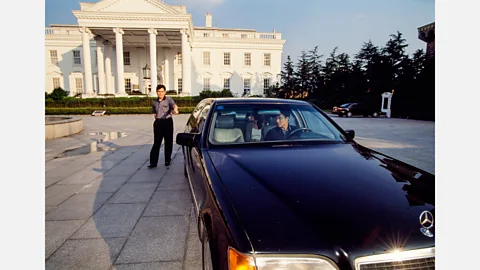 Lauren Greenfield/INSTITUTE
Lauren Greenfield/INSTITUTELauren Greenfield is no stranger to excess. The American photographer and documentary filmmaker has spent the past quarter century chronicling displays of wealth, excess and global consumerism.
She has now compiled 25 years of these images into a major retrospective exhibition at the ICP Museum in New York, with more than 200 photographs depicting affluence and consumer culture around the world, and how they influence identity.
Greenfield’s fascination with wealth and consumer culture began in Los Angeles in the early 1990s after she returned from an assignment to photograph a Mayan village in the highlands of Chiapas, Mexico. She had studied visual anthropology and realised there was something compelling and exotic about the world she grew up in: the image-conscious young people of Los Angeles and how they were influenced by celebrity.
“What I remembered growing up was this very materialistic environment – somehow that was having influence all over the world.
“I felt like a serious documentary project about that world was important but was also more my story to tell.”
Real estate billionaire Huang Qiaoling in front of his home, a replica of the White House, in Hangzhou, China in 2002.
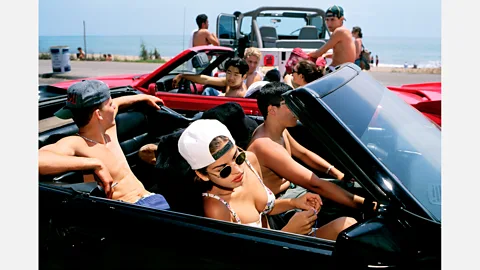 Lauren Greenfield/INSTITUTE
Lauren Greenfield/INSTITUTEWhile Greenfield’s interest in consumerism and excess spans decades, the idea to compile these images into one body of work came in 2008 when documenting how the middle and working classes were being hit by the global financial crisis.
“Seeing, in a way, how such different people were similarly affected turned all the stories for me into a morality tale about how we had been living.
“Then I started looking back and thinking about how in some ways these hundreds of stories I’d covered were actually one big story and what that story was.”
She went through more than half a million pictures. “Once I had this insight, that these stories were interconnected, when I went back to that early work in LA in the 90s – I saw a lot of the themes starting there both in my work and in the culture, [I] started tracking back the shift to the 80s and 90s.”
Beverly Hills High School student Mijanou with friends in Santa Monica, California, in 1993.
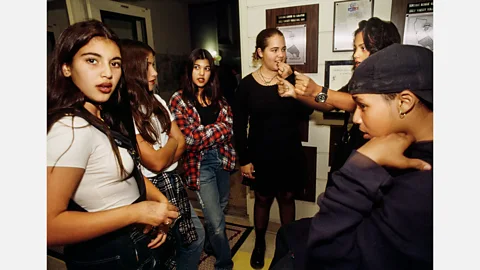 Lauren Greenfield/INSTITUTE
Lauren Greenfield/INSTITUTESo have attitudes toward wealth and consumption changed since the early 1990s? Greenfield thinks so.
“I think there was more discretion even then, especially from the parents’ generation. I remember the kids being very showy but when the first pictures were published in 1992, the parents of the kids were kind of embarrassed by them. There was a sense of maybe you could take a limo to a concert but maybe it wasn’t good to show that off.”
Kim Kardashian, 12, and sister Kourtney (third from left), 13, at a school dance in Bel Air, Los Angeles, 1992.
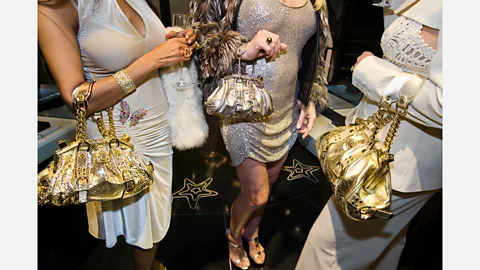 Lauren Greenfield/INSTITUTE
Lauren Greenfield/INSTITUTEThat had all changed by the time Greenfield was interviewing teenagers in the mid-2000s for her film Kids + Money. “The parents, some of the mothers were proudly saying… my daughter is like Nicole Ritchie or Paris Hilton, a complete shopaholic.”
She says TV shows like Paris Hilton’s The Simple Life helped shift attitudes toward consumer culture.
“Once reality TV happened, there was this kind of open ‘it’s OK to be rich’.
“By 2007, there was this willingness to be open about one’s materialism without shame that went across class.”
Jackie, 41, and friends at a private opening at the Versace store in Beverly Hills in 2007.
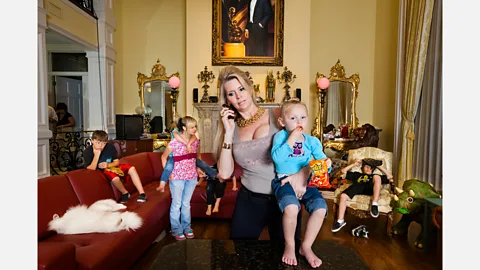 Lauren Greenfield/INSTITUTE
Lauren Greenfield/INSTITUTEBut then the global financial crisis happened. Greenfield says post-2008, she did see a change in displays of wealth and excess – for a while.
At the time, she was making a documentary, Queen of Versailles, about “timeshare king” David Siegel and his wife Jackie. “They were very proudly building the biggest house in America and wanted that accomplishment documented. It was really an expression of their excess and the American dream.”
The story became a morality tale about excess in the lead-up to and during the financial crisis: “At the end of Queen of Versailles, David and Jackie learn the errors of their ways. David says, ‘I should have built fewer resorts, I should have lived within my means.’ Jackie says, ‘I wish we didn’t take out the mortgage, I learned that family is family’.
“And yet, now they’re building the house again.”
Jackie Siegel and children at her home in Windermere, Florida, in 2009.
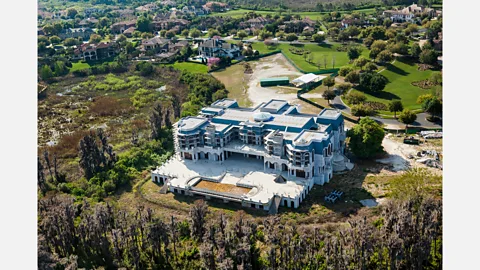 Lauren Greenfield/INSTITUTE
Lauren Greenfield/INSTITUTEShe says the harsh lessons learned from the burst of the housing bubble were short-lived. “As a society, we went right back to the same thing and in a way with even more vengeance.”
Greenfield saw an “almost manic consumption” following the collapse of the housing market.
“There was kind of a wealth destruction in a way, throwing up money, throwing up thousands of dollars and really living for today.” As an example, “I photographed a nightclub in Los Angeles where people spend up to $50,000 a night on bottle service. You have both very rich, but you also have people they call the ‘$30,000-a-year millionaire’, where somebody saves the whole year to be a baller for one night.
“If you look at where we are now, our stock market is going crazy, the housing market is crazy again and it’s hard to believe that we took to heart those lessons from the crash.”
“Versailles”, the immense home built by David and Jackie Siegel in Windermere, Florida, was the subject of Greenfield’s 2012 film The Queen of Versailles.
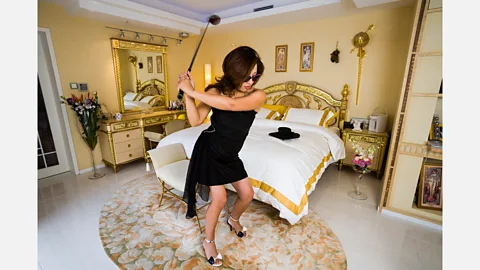 Lauren Greenfield/INSTITUTE
Lauren Greenfield/INSTITUTEGreenfield’s global take on wealth has taken her to China and Russia, “places where revolutions had tried to abolish class and inequality – there was an even kind of stronger desire for luxury and presentation-based status.”
She points to a surging interest in typically upper-class pursuits such as yachting and polo, and in China, etiquette lessons.
“By 2014, both Russia and China, people didn’t just want designer brands anymore… they wanted class, they wanted culture – they wanted what money can’t buy, which they tried to buy.”
Despite this, she believes global elites are fairly similar in the ways they consume and display their wealth, no matter their nationality. “The shared values of the 1% [go] beyond national identity. A love for yachts and Hermes and the most expensive sport in the world – Formula 1 – is enough for people to vacation together and have this common ground.”
Xue Qiwen, 43, in her Versace-decorated apartment in Shanghai, 2005.
 Lauren Greenfield/INSTITUTE
Lauren Greenfield/INSTITUTEShe has definitely noticed the influence of social media on how people display wealth today.
"I think that social media has compounded the focus on branding, the focus on image – you have teenagers selling stuff. You have teenagers wanting to buy stuff.
“The popularity game is enhanced because there’s what my son calls FOMO – fear of missing out – and everybody’s got a more exciting, more glamorous, sexier life than you do on social media.
“The work at the end of the day is really about how capitalism sows insecurities that then make us avid and vulnerable consumers.
“Wherever there’s insecurity and a desire to be something other than what you are, that really feeds capitalism. Social media is really a catalyst for that.”
She says it is the right time to make a statement about the “addictive quality” of consumerism.
“I hope that the work – putting it all together – will be a little bit of a wake-up call in terms of our values and how we’re living. Because I don’t think we can continue indefinitely on this path.”
Ilona Stolie and her daughter Michelle, 4, in their Frank Lloyd Wright-inspired Moscow home in 2012.
Generation Wealth was originally shown at the Annenberg Space for Photography and is currently on view at the ICP Museum in New York City.
